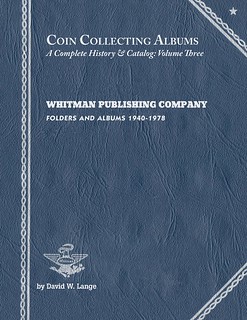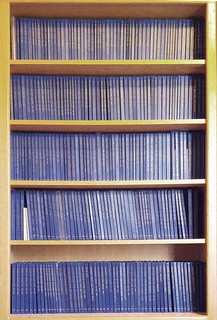
PREV ARTICLE
NEXT ARTICLE
FULL ISSUE
PREV FULL ISSUE
COLLECTING WHITMAN BOOKSHELF ALBUMSDave Lange recently published Coin Collecting Albums, A Complete History & Catalog: Volume Three, Whitman Publishing Company Folders and Albums 1940-1978. In an email to his mailing list this week, he provided a section inadvertently left out of the book. With permission, we're republishing it here. Thanks. -Editor Dave writes: "A sharp-eyed reader of my new book inquired why there was no section titled "Collecting Bookshelf Albums," as there are equivalent sections on each of the other Whitman products. The simple answer is that it was written and somehow lost during the layout process. I failed to notice this omission, a great embarrassment to me. "It is attached herein, along with a photo of the author's own collection of these albums."
Whitman Bookshelf albums are case bound, as with a hardcover book, and this ultimately contributed to the line's undoing years later. With frequent use the covers of Bookshelf albums can separate from their stubs, as they are attached solely by heavy staples that are covered by the pastedown paper. If one attempts to make the albums lie flat, the pastedown can tear away from the staples, and many used Bookshelf albums are found in this state. Another condition issue is that the gold printing of the front cover and spine tends to wear off of Bookshelf albums from the First Edition. Early in the Second Edition, Whitman adopted metallic gold printing that was brighter from the outset and far more durable. This serendipitous development lasted only 1972-74, and for the final few years of production the cover text reverted to its former matte finish, probably for cost reasons. There are many rarely seen albums in the Bookshelf line, but that does not necessarily translate to high values. The secondary market for these albums as a whole is not strong, despite their very attractive design and color scheme. When they are sought, it is for use in storing coins and not as collectibles in their own right. Actually, there are a number of individual varieties within particular titles that are quite rare, but the collecting of these albums to such a degree is perhaps an affliction suffered by the author alone. The real market in Whitman Bookshelf albums is a practical one, limited mostly to persons who recall them from the 1960s-70s and wish to continue their collections utilizing these familiar products. The author, too, employs Whitman Bookshelf albums for all of his circulated coin series to great satisfaction. He also finds that certain titles are always worth purchasing for resale whenever found in nice condition, and these include all those for Liberty Seated coins. Another good seller is the Bookshelf album for Large Cents, though experience has demonstrated that its opening are sometime a big snug for early date cents. The only titles that consistently realize high prices in the secondary market are those for which other albums are lacking today. The most highly sought ones are the type set albums for Mexico, Panama and The Philippines. These are legitimately rare and in constant demand. Still desirable but less costly are the several albums for Canada, Great Britain and Australia. The Canadian Large Cents album and the Newfoundland type set album in particular are fairly scarce and can bring good money. Of the British albums, the most valuable on the secondary market are those for Queen Victoria's farthings, halfpennies and pennies by date, mint and variety, 1860-1901. The various albums for tokens and medals are all very scarce, as are some of the custom printings for Presidential Art Medals, Inc. The latter are found either with or without the medals, and those featuring medals often are lacking some of later entries in their respective series. Over a period of years many subscribers to these medals lost interest and dropped out of the pursuit. The three albums for the Presidential Series, the first one launched, are the easiest to find. The later Statehood Series is noticeably scarcer in both the medals and the albums, particularly Volume 2. The Declaration Signers Series medals were of limited interest from the outset, and both the medals and the albums are rare. Volume III of that series is perhaps the rarest of all Bookshelf albums, and it is the only entry in all three series to bring a strong price in auction sales. Another very rare Bookshelf album is the custom printing for Franklin Mint. This album holds the first series of dollar tokens coined for Nevada gaming casinos after the disappearance of silver dollars in 1964. The two varieties listed in the First Edition catalog are quite are with or without the medals, yet empty examples do not bring very high prices. As of this writing there is little collector interest in the albums themselves. Also of limited interest and modest aftermarket value are the two albums for Israeli coins custom printed for R. P. Nielsen.
If you own a copy of the book, contact Dave at DavidWLange@outlook.com and he'll send you a .pdf file you can print and insert into your copy. -Editor
For more information, or to order Dave's book, see:
To read the earlier E-Sylum article, see:

Wayne Homren, Editor The Numismatic Bibliomania Society is a non-profit organization promoting numismatic literature. See our web site at coinbooks.org. To submit items for publication in The E-Sylum, write to the Editor at this address: whomren@gmail.com To subscribe go to: https://my.binhost.com/lists/listinfo/esylum All Rights Reserved. NBS Home Page Contact the NBS webmaster 
|

